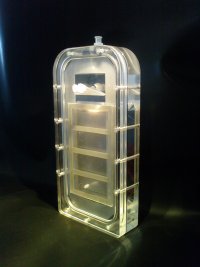Morgan Advanced Materials is working with ErySave on a pioneering new medical application using particle separation by ultrasound (PARSUS). The company has developed a disposable piezoelectric ceramic plate for this novel medical technology, which is ideal for applications such as the separation of micro emboli from blood during open-heart surgery.
Separation by ultrasound has many advantages compared to filtration and centrifugation devices; it is continuous, quiet and does not experience fouling. The absence of cell trauma and haemolysis combined with high separation quality means that using PARSUS technology in medical devices will improve the experience for patients undergoing surgery and reduce the need for blood transfusion.

The piezoelectric ceramic is the key enabling technology in the ultrasound; when it is applied with an electric current the material expands and contracts rapidly, creating the ultrasound. ErySave approached Morgan Advanced Materials for its technical expertise and customised manufacturing capability. The materials specialist recommended a piezo ceramic with a low porosity, high density composition. It was specifically designed for power ultrasonic applications associated with low losses under voltage and thermal stresses.
"Our technical Team lead by Fred Pimparel and our engineering team lead by Andrew Cooper has enabled us to design a truly low cost disposable unit," says Jon Mould, Actuator Business Manager, Morgan Advanced Materials. "We are honoured to be involved with the development of a technique which brings the technology one step closer to improving experience for many more patients undergoing surgery."
PARSUS technology works by the principle of separating particles in a fluid by applying it with an ultrasonic high frequency vibration. It is based on the fact that blood components display different physical parameters, such as acoustic impedance. The separation chamber and the applied ultrasound frequency are adapted to provide optimal separation characteristics.
An ultrasonic wave is directed through moving blood to gently remove emboli while recovering the red blood cells. The lighter lipids are directed into a waste reservoir and the majority of red blood cells are separated and retained using low energy forces that do not cause adverse stress.
"We have been pleased with initial results using this technique and the application for separation of micro emboli during open heart surgery is just the beginning of a new era of separation," says Dr. Henrik Bjursten, ErySave. "While ultrasound has been used in healthcare for over 40 years, this is the first industrial level development of ultrasound as a means of separation for medical applications and it has never been done on such a scale before."
The various characteristics of ceramic materials make them an ideal choice for a wide range of medial applications, from implants to surgical tools. Morgan Advanced Materials works with many leading medical device manufacturers, providing them with technical expertise and ceramic components for applications including ultrasonic imaging, surgical cutting and bone growth simulation.